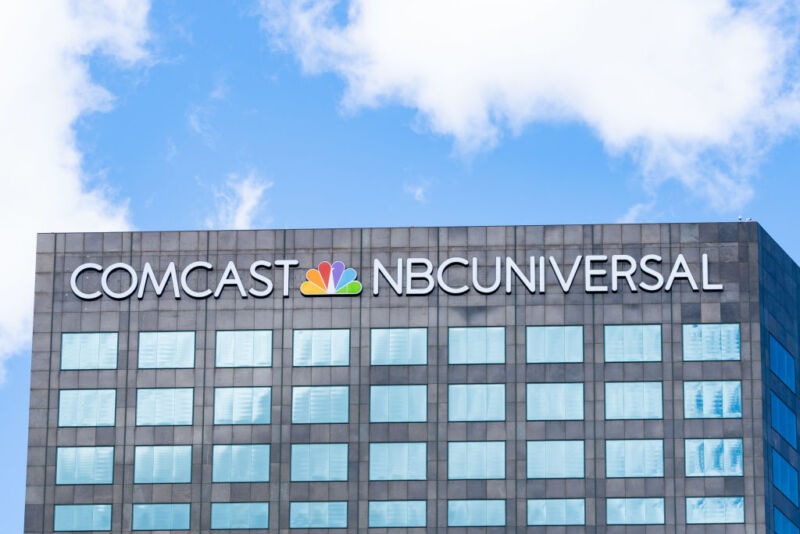Comcast wants to tie its cable/Internet to your streaming subscriptions.

In an ironic twist, cable TV and Internet provider Comcast has announced that it, too, will sell a bundle of video-streaming services for a discounted price. The announcement comes as Comcast has been rapidly losing cable TV subscribers to streaming services and seeks to bring the same type of bundling that originally drew people away from cable to streaming.
Starting on an unspecified date this month, the bundle, called Streamsaver, will offer Peacock, which Comcast owns, Apple TV+, and Netflix to people who subscribe to Comcast’s cable TV and/or broadband. Comcast already offers Netflix or Apple TV+ as add-ons to its cable TV, but Streamsaver expands Comcast’s streaming-related bundling efforts.
Comcast didn’t say how much the streaming bundle would cost, but CEO Brian Roberts said that it will “come at a vastly reduced price to anything in the market today” when announcing the bundle on Tuesday at MoffettNathanson’s 2024 Media, Internet and Communications Conference in New York, per Variety. If we factor in Peacock’s upcoming price hike, subscribing to Apple TV+, Netflix, and Peacock separately would cost $39.47 per month without ads, or $24.97/month with ads.
According to Roberts, Comcast is hoping that the upcoming package will help Comcast “add value to consumers” and “take some of the dollars out of” other streaming businesses.
For subscribers, the more immediate effect is the continuing and rapid blurring of the lines between cable and streaming services. And Comcast knows that.
As Roberts notes: “We’ve been bundling video successfully and creatively for 60 years, and so this is the latest iteration of that.”
Comcast is hemorrhaging subscribers
Last month, Comcast said it lost 487,000 cable TV subscribers in Q1 2024. It ended the quarter with 13,600,000 subscribers, compared to 14,106,000 at the end of 2023 and 16,142,000 at the end of 2022.Advertisement
Comcast’s broadband subscriber base also decreased from 32,253,000 at the end of 2023 to 32,188,000.
Peacock, Comcast’s flagship streaming service, hasn’t made any money since launching in 2020 and lost $2.7 billion in 2023. However, in April, Comcast said that Peacock’s Q1 losses lessened from $704 million in Q1 2023 to $639 million in Q1 2024.
It’s worth noting that in January, Comcast raised prices for its cable and Internet services by 3 percent, blaming the price hikes on broadband investments and an increase in programming costs.
Déjà vu
One of the common reasons people abandoned cable TV were bundled packages that forced people to pay for services, like phone or Internet, or channels that they didn’t want. Now, Comcast is looking to save its shrinking subscriber base by bundling its cable TV or Internet service with some of its biggest competitors. Like streaming services, Comcast is hoping that bundling its products will deter people from canceling their subscriptions since they’re tied to each other.
Subscriber churn is also a problem in the streaming industry. Antenna, a subscription analyst company, estimates that around 25 percent of video-streaming subscribers in the US have canceled at least three such subscriptions in the last two years. These high-churn subscribers represent around 40 percent of new subscriptions and cancellations last year, Antenna told The New York Times in April.
But Comcast’s announcement hints at déjà vu as Comcast blatantly seeks to re-create the cable bundle or triple-play package using the very streaming services that are eating away at Comcast’s cable business. Ironically, Comcast is seeking to bandage a declining business by feeding some of the biggest contributors to that decline, using the same tactics that drove many customers away in the first place.
We’re expected to hear a lot more about bundled services. Last month, we learned that a Disney+, Hulu, and Max bundle would be released this summer, for example. And there’s already a lengthy list of streaming bundle packages available from third parties like Verizon and T-Mobile.
But for people who left cable to avoid overloaded bundled packages and to get away from companies like Comcast, which group cable TV or Internet with streaming services that often raise prices, limit show and movie availability and features, and increasingly focus on ads, it just isn’t worth the monthly savings.




